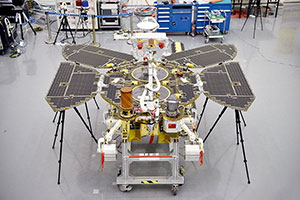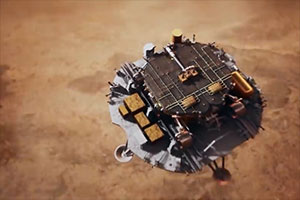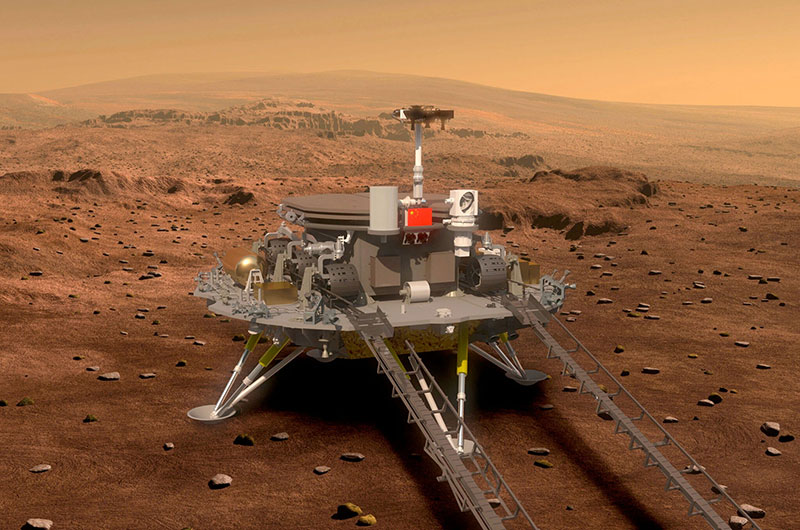 advertisements advertisements
|

|
China lands rover on Mars, making history on Tianwen-1 mission
May 14, 2021 — China has made history landing a spacecraft and rover on Mars.
The Tianwen-1 lander and Zhurong rover touched down on Friday (May 14), ten months after launching from Earth and three months after arriving at Mars with the Tianwen-1 orbiter. They robotic probes landed at 7:18 p.m. EDT (2318 GMT) in Utopia Planitia, a large impact basin on Mars.
"The lander carrying China's first Mars rover has touched down on the red planet," the China National Space Administration (CNSA) said in a statement. "It is the first time China has landed a probe on a planet other than Earth."
The landing was accomplished by China on its first try, during its first successful interplanetary mission. Tianwen-1 was the country's first success and second attempt at orbiting Mars after a failure in 2011 to leave Earth orbit with a Russian Mars-bound mission. China is now second to the United States, which until Friday was alone in operating spacecraft and rovers on the Martian surface. (The former Soviet Union landed the Mars 3 probe with a small rover in 1971, but the mission failed 110 seconds after touching down.)
China's lander and rover began their descent to the surface at about 4:00 p.m. EDT (2000 GMT) by separating from the Tianwen-1 orbiter, which since March has been used to capture imagery of the targeted landing site for study. An aeroshell protected the stacked probes as they plunged into the atmosphere at 3 miles per second (4.8 km per second), generating tremendous heat in the process.
Once inside the atmosphere, while traveling at supersonic speeds, the spacecraft deployed a 2,150-square-foot (200 sq. meter) parachute to slow its approach to less than 328 feet per second (100 m per second). China based the canopy design on the parachutes it has used on Shenzhou missions to return astronauts to Earth.
Finally, the Tianwen-1 lander fired thrusters similar to the type on China's Chang'e lunar landers to make the final descent. A laser range finder and a velocity sensor helped guide the craft as it hovered at about 328 feet (100 m) to identify obstacles and measure the slopes of the surface before touching down safely.
"Each step had only one chance, and the actions were closely linked. If there had been any flaw, the landing would have failed," Geng Yan, an official at the Lunar Exploration and Space Program Center of the CNSA, told the Xinhua state news agency.
Landing in the same vicinity on Mars where NASA's Viking 2 probe was deployed in 1980, the Tianwen-1 lander will serve as a platform for the six-wheeled Zhurong rover to drive off onto the surface. The 529-pound (240-kg) Zhurong, which is about the same size as NASA's Spirit or Opportunity Mars Exploration Rovers, will then unfold its solar panels to power its three-month primary mission.
China outfitted the rover with six science instruments to collect data about the terrain, soil and atmosphere at Utopia Planitia. The payloads include multispectral and navigation cameras, a laser-equipped spectrometer, magnetometers to measure the planet's magnetic field and a suite of tools to study the local climate.
Zhurong also has a ground-penetrating radar, which will be used to search for subsurface water. Earlier Mars missions have found evidence for pockets of liquid water and have pointed at Utopia Planitia as being a likely site for such. Zhurong will be the first to look for such deposits from the ground.
"Zhurong," which name references a figure from Chinese folklore associated with fire and light, was named through an online public poll. Tianwen, or "questions to heaven," is taken from a poem written by the ancient Chinese poet Qu Yuan, who raised questions in verse involving the sky, stars, natural phenomena, myths and the real world. "Tianwen" is expected to be the name of all of China's future Mars and interplanetary missions.
Tianwen-1 is the tenth spacecraft in history to land and successfully function on Mars, including NASA's Mars Curiosity and Perseverance rovers which are active on the surface. |
|

Artist rendering of China's Tianwen-1 lander approaching a landing on the surface of Mars with the Zhurong rover on board. (CGTN)

China's Zhurong rover, seen here being prepared for its launch, has become the country's first spacecraft to land on Mars. (CNSA)

Artist rendering of China's Tianwen-1 lander with the Zhurong rover descending to the surface of Mars. (CGTN) |

Artist's rendering of China's Tianwen-1 lander and Zhurong rover on the surface of Mars, a first for the country. (China National Space Administration) |
|

© collectSPACE. All rights reserved.
|
|

|

|
